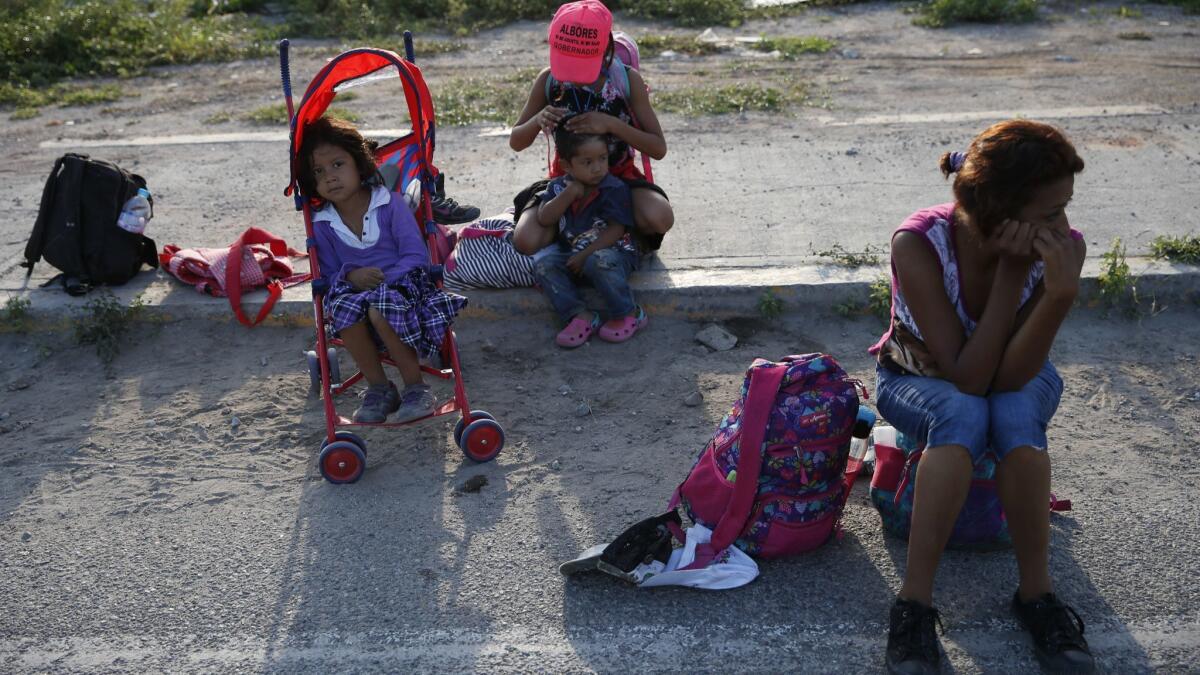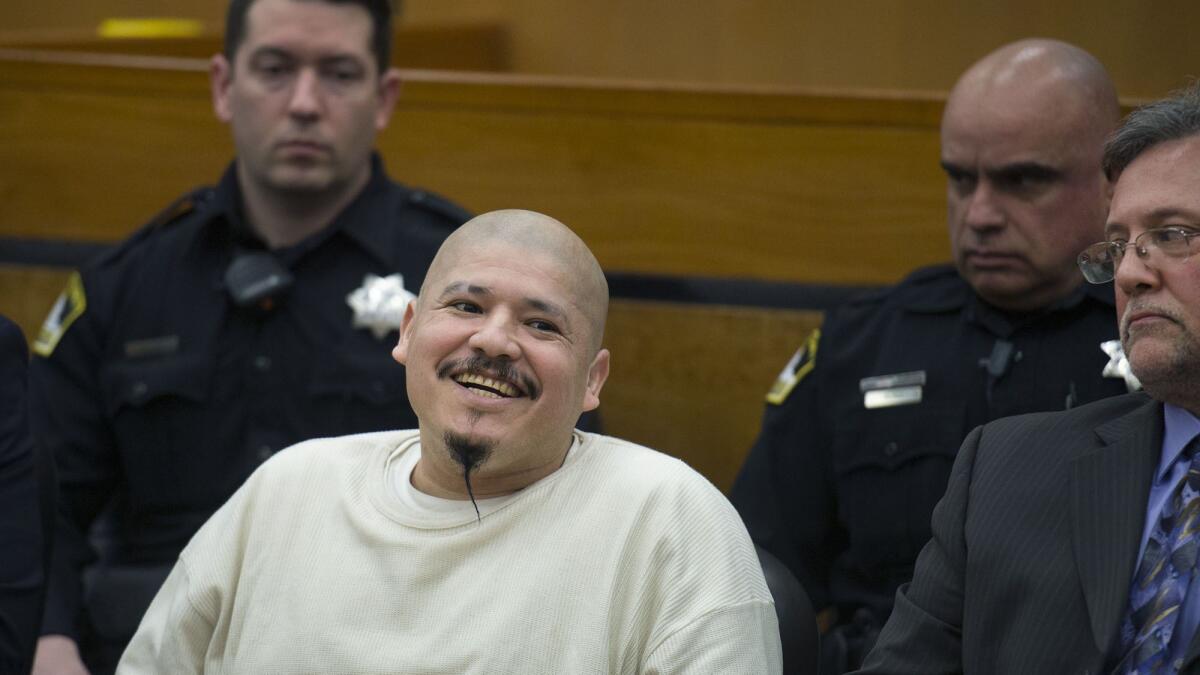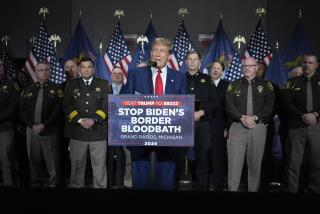How Trump has used three horrific California slaying cases to demonize immigrants

From the time President Trump stepped onto the campaign trail more than two years ago he’s pointed to three high-profile California slaying cases to highlight the dangers of what he contends is the country’s broken immigration system.
Like his invocation of the gang MS-13 and focus on the migrant caravan making its way toward the U.S. from Central America as the midterms approach, immigrants — in the country illegally and legally — have been wielded by Trump as a political weapon.
His insistence on doing this has been met with waves of criticism by those who assert that Trump is scapegoating immigrants as a racist, fear-mongering tactic to influence voters. The tactic has also run in the face of numerous studies that have shown that immigrants commit less crime than native-born Americans.
“The vast majority of research finds that immigrants do not increase local crime rates and that they are less likely to cause crime and less likely to be incarcerated than their native-born peers,” according to a study released earlier this year by the Cato institute, a libertarian public policy research organization.
The author of the study, Alex Nowrasteh, examined 2015 data from the Texas Department of Public Safety and found that homicide conviction rates for illegal and legal immigrants were 16% and 67% below those of native-born residents, respectively.
But findings like these have never stopped Trump — and they didn’t Wednesday, when the president posted on Twitter a video blaming Democrats for “letting in” Luis Bracamontes, a man who killed two Northern California deputies four years ago while in the country illegally, and encouraging voters to cast their ballots for Republicans.
A jury convicted Bracamontes this year of fatally shooting Sacramento County sheriff’s Deputy Danny Oliver outside a motel in an incident that triggered a manhunt and chase that lasted hours and spanned 30 miles. Bracamontes fatally shot Placer County sheriff’s Det. Michael Davis Jr. before he was captured. The video opens with images of him smiling in a courtroom as he admits that he killed deputies and doesn’t regret it. However, statistics show the case and others like it remain an outlier.
Trump’s reelection campaign aired a 30-second ad in January featuring Bracamontes and accusing Democrats of being “complicit” in the slayings of law enforcement officers by people in the U.S. illegally.

It was released on the anniversary of Trump’s inauguration amid a government shutdown sparked by Democrats’ refusal to support a spending plan unless Republicans agreed to protect hundreds of thousands of young immigrants from deportation.
In a pinch, the video brings the conversation back to immigration to excite his base and with midterm elections just a few days away, Trump is trying to keep enthusiasm for the party high, said Louis DeSipio, a professor of political science at UC Irvine.
“He can show his commitment to the values of the core of the Republican electorate by articulating a harsh, nationalistic, anti-immigrant message,” he said.
While the message doesn’t speak to moderates, it doesn’t matter because it resonates with poor, white voters. Most live in rural areas with competitive Senate races, such as North Dakota, Missouri and West Virginia, DeSipio said.
Still, Trump is unique among other politicians — such as former California Gov. Pete Wilson — who have used illegal immigration as a rallying cry. Most politicians will episodically use anti-immigrant rhetoric and policies. Trump does it with almost religious observance — steadily and passionately.
“Trump is different in that he has staked his political career on a consistent anti-immigrant message that targets lots of immigrant groups — not just Mexicans and Chinese,” DeSipio said.
Painting immigrants as criminals is key, as is highlighting examples of people killed by immigrants who are in the country illegally.
At the same time, Trump hedges when mass violence is conducted by white men, such as the Charlottesville, Va., nationalist rallies that ended in the death of Heather Heyer.
Trump argued there was blame on both sides and equated the actions of white nationalists, carrying Nazi flags and chanting, “Jews will not replace us,” to that of counter protesters, DeSipio said.
“You had some very bad people in that group, but you also had people that were very fine people, on both sides,” Trump said shortly after the rallies.
Trump expressed outrage again last year when Jose Ines Garcia Zarate, a Mexican national who had been deported five times and freed under sanctuary laws, was acquitted of murder and manslaughter charges in the fatal shooting of a Bay Area woman.
Kathryn Steinle’s slaying in 2015 had become a flashpoint in the national debate over illegal immigration in the U.S. and the role of local police in enforcing federal immigration laws. Trump had cited Steinle’s death during his campaign to make his case for building a wall across the U.S.-Mexico border.
“This senseless and totally preventable act of violence committed by an illegal immigrant is yet another example of why we must secure our border immediately,” Trump, a presidential candidate at the time, said in a statement two days after Steinle died. “This is an absolutely disgraceful situation, and I am the only one that can fix it.”
He told CNN that year: “This man, or this animal, that shot that wonderful, that beautiful woman in San Francisco, this guy was pushed back by Mexico. Mexico pushes back people across the border that are criminals, that are drug dealers.”
During his trial, Garcia Zarate’s attorney called an expert who testified that an unintentional ricochet shot killed Steinle. They argued that the weapon, which had been stolen days earlier from a federal ranger’s parked car, went off in their client’s hands in what was a tragic accident.
The politicization didn’t go unnoticed by Steinle’s family.
“For Donald Trump, we were just what he needed — beautiful girl, San Francisco, illegal immigrant, arrested a million times, a violent crime and yadda, yadda, yadda,” Liz Sullivan, Steinle’s mother, told the San Francisco Chronicle, according to a report published two months after the shooting. “We were the perfect storm for that man.”
Not every victim’s family has rebuffed connections to the immigration debate. Some have even embraced it.
Trump has frequently made reference to Los Angeles High School football standout Jamiel Shaw II, who was gunned down near his Arlington Heights home in 2008 by a gang member who was in the country illegally.
Pedro Espinoza, who had been freed from jail two days before the fatal shooting without immigration authorities placing a hold on him, was convicted of first-degree murder in 2012 and sentenced to death for Shaw’s slaying.
Shaw’s father, also named Jamiel, has repeatedly aligned himself with Trump especially over issues related to immigration. He appeared at a Costa Mesa campaign rally and the Republican National Convention in 2016 for the then-presidential candidate to discuss open borders.
Trump was “sent by God,” Jamiel Shaw Sr. proclaimed at the time, because he would “build the wall.”
Twitter: @Hannahnfry
More to Read
Start your day right
Sign up for Essential California for news, features and recommendations from the L.A. Times and beyond in your inbox six days a week.
You may occasionally receive promotional content from the Los Angeles Times.








